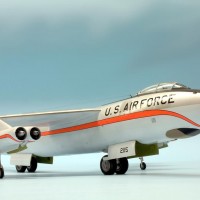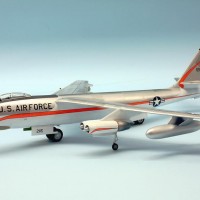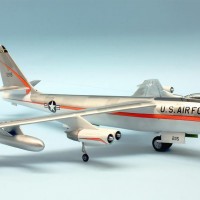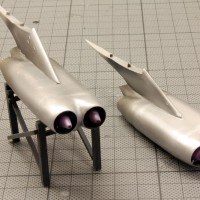“W” stands for Weather! Boeing WB-47 Stratojet from Hasegawa
I would like to show you this model, which was built some time ago, because it is a classical kit rarely seen built. I hope you like the pictures!
The designation "WB-47B Stratojet" will perhaps interest some readers; because where does the letter "W" before the well-known and usual type designation of the Stratojet come from?
Since 1943, the then USAAF has operated its own weather reconnaissance squadrons, which were supposed to clarify the weather events in the respective Air Force operations areas, but were also able to collect data for basic meteorological research. My model shows a B-47, which was adapted for this special task and was used from 1956 on by the 55th WRS (Weather Research Squadron) from McClelland AFB.
I would like to go into the mission of the WB-47 in more detail below, but before that it might be interesting to have a quick look at the epoch-making aircraft type and the kit, which is already quite old.
Even today the B-47 can still be considered a really shapely and highly elegant design, which is all the more astonishing when you consider that the revolutionary layout was already established in the mid-1940s. The long wings are with 35 degrees strongly arrowed - by the way, they are much more extreme than the German developments of this time and they carry stripped engine nacelles. All this poses a major technical challenge, which also made it necessary to relocate the main landing gear in a tandem arrangement in the fuselage.
In December 1947, the first flight took place and the first production aircraft were handed over to the newly formed USAF in 1951. The training of the crews on this aircraft, which offered numerous innovations, required further time, so that the StratoJet was not used over Korea. It was not until 1953 that the B-47 replaced its interim predecessor, the "B-45 Tornado", in large numbers in the task forces.
Although the B-47 was considered reliable and easy to maintain, it required flying skills, especially during take-off and landing. Both double-tyred main landing gear systems had to leave or touch the ground at the same time. This led to high landing speeds, which put a great deal of strain on the airframe but also on the nerves of the crews. With its six J-47 turbines, the B-47 proved to be notoriously underpowered - probably a problem of all first generation jets.
The Stratojet remained in service with the Strategic Air Command until 1965, when it was replaced by the B-52. Over Vietnam some B-47s still performed valuable services in electronic reconnaissance, but by the end of the 60s these aircraft under the Tactical Air Command were also decommissioned.
A number of Weather Reconaissance Squadrons used the "WB-47" to extract data from the atmosphere. This included flying in thunderstorms or tornadoes, but also using a "nuclear debris sampler" to analyse the effects of Soviet nuclear bomb tests.
Hasegawa offers with this venerable kit the only possibility to build a B-47 as far as I know. However: when the kit forms were created, myself was just one year old and the WB-47B was still flying... So slowly it's time for a nice contemporary kit of this important milestone!
But Hasegawa has put some very useful items into the box. The shapes seem to be harmonious and the parts shine with quite good fitting accuracy. But you won't find any details in the cockpit or in the wheel wells. So it is a good idea to have a look around the wide aftermarket offer. For this model I bought a voluminous cockpit set, a set of resin tires and new turbines - all from Pavla. Really I can only recommend the renewed tires and the turbines, although the amount of work to adjust them is no less!
The cockpit disappears to 95 percent in the fuselage. Only those who are interested in fine details and who are satisfied with a few photos of the invisible splendour should try this.
The enclosed deep-drawn pulpit was much too streaky for me to invert the additional work. On the model you can see the original pulpit. But this one has to have a longitudinal center strut.
By the way, the markings are from "Warbird Decals", they are very easy to work with. To my delight the Hasegawa decals, which were probably produced in the mid 80s, were also easy to work with. These are necessary to make the walkways and the markings on the tops of the wings.
The aluminium surfaces were again designed with Alclad II products. I was especially interested in this NMF project to show the different stresses and "stress wrinkles" in the metal. For this purpose, the airbrush was repeatedly guided vertically up and down, and this for all colours up to the final clear lacquer sealing. I like the result - unfortunately not optimally visible on the photos - quite well, I will continue to do so in the future.
The B-47 StratoJet was an extraordinary building pleasure for me, which I can recommend to everybody. The accuracy of fit and also the small number of parts makes the kit recommendable even for the moderate beginner; who wants to let off steam with detailing, however, will find a splendid playground.



















































That's a beautiful Stratojet, Roland!
Nice building sequence pics too!
All the best!
Outstanding!
A beautiful job on a beautiful aircraft! Nicely done.
Really great work Roland!
Cheers,
Scott
Thank you for sharing Roland. A excellent article with professional photo's. The model is nothing short of being "Art". Some of the strongest work to be shown on this form given the models age and it being the only plastic on the market. Nothing short of being professional and something one would see and read in hard copy.
Two thumbs up. If there where a "Model of the Month" you'd win hands down.
Great build Roland. I've always had a weak spot for the B-47, my great uncle was part of this project when he worked for Boeing.
Looks good and different Roland, well done.
Very nicely done.
I am very impressed and delighted with your comments - thank you very much.
You make me a little bit proud!
W stands for wonderful work
A very hard job with impressive result. Very inspiring to old and young modelers.
These are very charming remarks, thank you both for that!
Well done - a very nice scheme on the venerable B-47.
hello Roland,
Thanks for your in depth contribution.
I enjoyed it, the text and the excellent photographs.
Regards, Dirk / The Netherlands.
Greg and Dirk, thank you very much for your very appreciated comments!